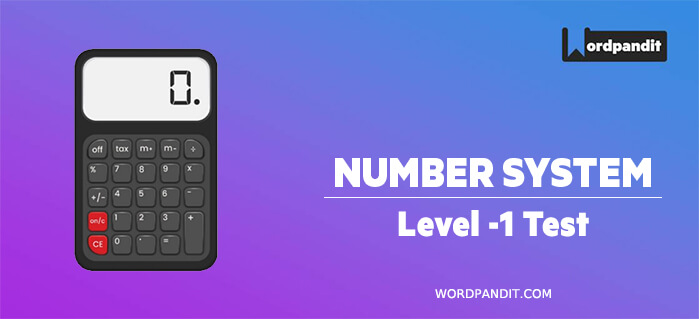- This is an assessment test.
- To draw maximum benefit, study the concepts for the topic concerned.
- Kindly take the tests in this series with a pre-defined schedule.
Number System: Level 1 Test - 4
Congratulations - you have completed Number System: Level 1 Test - 4.You scored %%SCORE%% out of %%TOTAL%%.You correct answer percentage: %%PERCENTAGE%% .Your performance has been rated as %%RATING%%
Your answers are highlighted below.
Question 1 |
The value of (1-d^3)/(1-d) is
> 1 if d > -1 | |
> 3 if d > 1 | |
> 2 if 0 < d < 0.5 | |
< 2 if d < -2 |
Question 1 Explanation:
Given that (1 – d^3) / (1 – d) We can write it (1 – d)(1 + d + d^2)/(1 – d).
Now come to the options:
see the expression (1 + d + d^2).
If d > 1, then d^2 > 1 and (1 + d + d^2)> 3.
Hence, option B is the right answer.
Now come to the options:
see the expression (1 + d + d^2).
If d > 1, then d^2 > 1 and (1 + d + d^2)> 3.
Hence, option B is the right answer.
Question 2 |
In a six-node network, two nodes are connected to all the other nodes. Of the remaining four, each is connected to four nodes. What is the total number of links in the network?
13 | |
15 | |
7 | |
26 |
Question 2 Explanation:
You can find that the total number of links in the network is 13.
(Note : the top two nodes are connected to all the other nodes,
while the remaining four are connected to only four other nodes).
Students should be careful and do not forget to count
the actual sides of the hexagon as well, as they also form links.
(Note : the top two nodes are connected to all the other nodes,
while the remaining four are connected to only four other nodes).
Students should be careful and do not forget to count
the actual sides of the hexagon as well, as they also form links.
Question 3 |
5^6 – 1 is divisible by
13 | |
31 | |
5 | |
None of these |
Question 3 Explanation:
Lets breakdown the equation:
5^6 – 1 = (5^3)2 – 1
= (125)^2 – (1)^2
= (125 + 1) (125 – 1)
= 124 × 126 = 31 × 4 × 126. So among the given answer choices, the given number is only divisible by 31
= (125)^2 – (1)^2
= (125 + 1) (125 – 1)
= 124 × 126 = 31 × 4 × 126. So among the given answer choices, the given number is only divisible by 31
Question 4 |
116 people participated in a singles tennis tournament of knock out format. The players are paired up in the first round; the winners of the first round are paired up in second round, and so on till the final is played between two players. If after any round, there is an odd number of players, one player is given a bye, i.e. he skips that round and plays the next round with the winners. Find the total number of matches played in the tournament.
115 | |
53 | |
232 | |
116 |
Question 4 Explanation:
This is very simple question,
but these type of questions are only asked in CAT to consume your time.
Since there are 116 players in all and we have to choose 1 winner,
there have to be 115 losers in all.
And since 1 match gives 1 loser, there has to be 115 matches to be
played in the complete tournament.
but these type of questions are only asked in CAT to consume your time.
Since there are 116 players in all and we have to choose 1 winner,
there have to be 115 losers in all.
And since 1 match gives 1 loser, there has to be 115 matches to be
played in the complete tournament.
Question 5 |
Two positive integers differ by 4 and sum of their reciprocals is 10/21. Then one of the numbers is
3 | |
1. | |
5 | |
21 |
Question 5 Explanation:
Let one number be x, so the other number would be (x + 4).$\begin{align}
& \frac{1}{x}+\frac{1}{x+4}\,=\,\frac{x+x+4}{x(x+4)}=\,\frac{10}{21} \\
& \frac{2x+4}{{{x}^{2}}\,+4x}=\,\frac{10}{21} \\
& Solving\,for\,x,\,\,we\,get\,x=3 \\
\end{align}$
Short-cut
Students, please note that the sum of reciprocals is basically =Sum of the integers/Product of the integers.
Let two numbers be A and B.
The sum of their reciprocals is=$\frac{1}{A}+\frac{1}{B}\,=\,\frac{A+B}{AB}$
So, we have to find the two integers whose sum is 10 and whose product is 21.
So, x + (x + 4) = 10 or x = 3.
Short-cut
Students, please note that the sum of reciprocals is basically =Sum of the integers/Product of the integers.
Let two numbers be A and B.
The sum of their reciprocals is=$\frac{1}{A}+\frac{1}{B}\,=\,\frac{A+B}{AB}$
So, we have to find the two integers whose sum is 10 and whose product is 21.
So, x + (x + 4) = 10 or x = 3.
Once you are finished, click the button below. Any items you have not completed will be marked incorrect.
There are 5 questions to complete.
List |












Detailed explanation please..
Thanks for the posting such good questions in Number System: Level 1 Test – 4
section. Really enjoyed solving those questons.